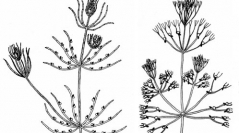

 Cryptogamie, Algologie
38 (3) - Pages 201-251
Cryptogamie, Algologie
38 (3) - Pages 201-251Characeae are macroscopic green algae present in the Maghreb (Morocco, Algeria, Tunisia) that are known since the 19th century works of Desfontaines (1800) and Braun (1868). Feldmann (1946) published the first regional synthesis, and this study provides a new Maghreb-wide synthesis of all collections made since 1784 (570 observations distributed over 464 sites). Each of the 31 reported species is described in detail with its diagnostic features, ecology and distribution in the three Maghrebian countries. Distribution maps distinguish between the three collection periods: 1780-1939, 1940-1979, and 1980- 2016. An illustrated key is provided to help botanists working in the Maghreb to identify the taxa. From a biogeographical perspective, the Characean flora of the Maghreb is dominated by elements originating from northern (European) countries (61.3%) that include regionally very rare species such as Chara strigosa and C. tomentosa. The Mediterranean-Atlantic element is also well represented (32.3%), with some Mediterranean endemics (Chara imperfecta, C. oedophylla, C. vulgaris var. gymnophylla). Finally, two taxa that have an affinity for tropical conditions (Chara zeylanica and Lamprothamnium succinctum) extend to the southern Sahara. In North Africa, 14 species (7 Chara, 2 Lamprothamnium, 4 Nitella and 1 Sphaerochara) are threatened and raise issues about their conservation; three of these are particularly endangered: Chara imperfecta, C. oedophylla and Lamprothamnium papulosum.